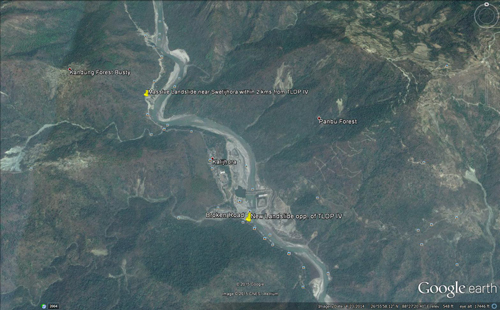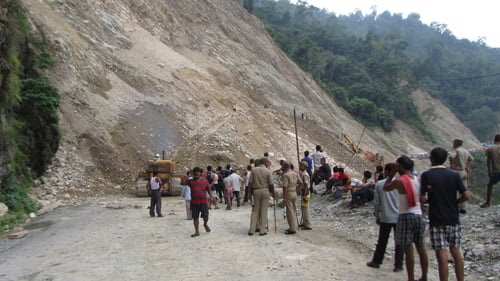Darjeeling, the iconic hill city and district in the eastern Himalayas, suffered its worst disaster in about five decades as a series of landslides killed 38 people in the early hours of July 1. Many more are injured, missing or homeless.
As in the 2013 Uttarakhand disaster which killed thousands, heavy rain triggered 25 separate landslides in Darjeeling, Kalimpong and Kurseong sub-divisions of West Bengal and caused huge damage in the picturesque area. Parts of two national highways were carried away by the landslides, and so was a bridge, cutting off major road links to the region.
According to state disaster management officials, the Mirik area of Darjeeling district has been worst hit with 22 deaths. Other deaths took place in Kalimpong, Lava, Sukhia and Gorubathan areas. West Bengal chief minister Mamata Banerjee and India’s junior home minister Kiren Rijiju rushed to Darjeeling – an area which for the past 30 years has been seeing a violent agitation for a separate state.
Experts say human activities have exacerbated the natural vulnerability of the area, a situation similar to the one in Uttarakhand. Geologists say the April 25 Nepal earthquake and its many aftershocks may have made the entire eastern Himalayas more vulnerable to landslides by loosening the soil and widening cracks on the hillsides.
“The rock in Darjeeling is fragile with low compactness. If you consider that the area has one of the highest rainfall in the country while its soil has extremely low water retention ability, clearly a landslide is always waiting to happen especially in a scenario where appropriate housing norms are hardly followed,” said Tapas Ghatak, a geophysicist and former expert in Geological Survey of India, who later moved to the state urban development department.
Darjeeling building norms flouted
Ghatak was a member of the state appointed expert committee in 2000 which suggested a series of building norms for the area, keeping the high probability of landslides in mind. The norms remain on paper.
“As per norm there should not be any construction in more than 30 degree slope but one can even find high-rises on 65 degree slope” Ghatak told thethirdpole.net. The expert pointed out that there has been no dearth of data about the possible landslide zones and steps to counter but lamented that nothing has been done on the ground. “Geological Survey of India undertook detailed landslide survey as did Unicef though a community based disaster management project from 2000 to 2006 but no concrete action was taken on basis on those.”
Chief Minister Banerjee announced on July 2 that the state government would approach the Geological Survey of India for yet another study on landslides in the area.
Environmentalists have blamed politicians for the situation. “Politicians have shown no vision as Darjeeling has become saturated with little planning and rules exist only on paper,” said Urmila Rumba of the NGO Darjeeling Earth Group.
“In the 1930s, the British government planned Darjeeling over an area of five square km and for about 20,000 to 30,000 people,” said Mamata Desai of Netaji Subhash Research Institute. The expert claimed that though the city area has almost doubled and the population size increased six-fold – much more if the tourist population is considered – since then, there has been little augmentation of the infrastructure for a city that does not even have a master plan.
Soumitra Ghosh of local NGO NESPON says there are four reasons for the present crisis:
- Unplanned construction without properly assessing slope stability or soil condition
- Rampant blasting in the hills for widening or building roads
- Continued deforestation and inappropriate planting up the slopes which damage top-soil
- Dams coming up all along the Teesta valley in North Bengal and adjoining Sikkim.
Geophysicist Ghatak explained, “If one compares point to point, then Darjeeling is no less vulnerable than Uttarakhand. Darjeeling’s population density is greater; rainfall is higher; number of rivers and rivulets more which adds risk; and also geologically it’s at risk. The only saving grace is Darjeeling falls in zone 4 on earthquake vulnerability while Uttarakhand is in zone 5.”

Who is to blame for the Darjeeling landslide?
Cutting across the spectrum, politicians now agree that there has been major neglect in combating the threats in Darjeeling. But they all blame others.
“Darjeeling’s environment is in very poor state; it has especially deteriorated over the last ten years. We tried but could not improve in the face of local politics,” said Asoke Bhattacharya, former urban development minister of West Bengal and a leader of the Communist Party of India (Marxist).
The current representative of Darjeeling in the West Bengal assembly, Trilok Dewan of the Gorkha Janamukti Morcha (Bimal Gurung group) agreed that politicians are largely responsible for the “unsustainable” environment of Darjeeling but blamed other parties.
“It’s a fact that politicians are responsible for the current state of affairs. However Bimal Gurung, since coming to power, has been trying hard,” said Dewan. Gurung heads the largely autonomous Gorkha Territorial Authority (GTA) that is supposed to be in charge of the district.
Asked what the GTA had done, Dewan blamed the present state government instead. “There is just a half page disaster management plan for Darjeeling and the disaster management arrangements are third class,” he said. He claimed that dual control of disaster management – by the state government and the GTA – is hurting the process. “The entire responsibility and power should be left with GTA,” said Dewan.
In reaction, a leader of the state’s ruling Trinamool Congress party said the blame lies with the former government and the local leaders of Darjeeling. “Neither the previous government nor the local leaders, be it Ghishing or Gurung, have done anything to minimise vulnerability of Darjeeling in a planned manner and only tried to gain political dominance. It’s only Mamata Banerjee who has been trying to protect Darjeeling by repeatedly visiting the hill town.”
A local politician retorted, “It’s a fact that Mamata Banerjee visits Darjeeling regularly; but that is not to protect Darjeeling but to create a political foothold.”
Darjeeling district has had 16 major landslides in last 138 years killing an estimated 1,300. But 25 landslides in one night of heavy rain show it is sliding steadily.

